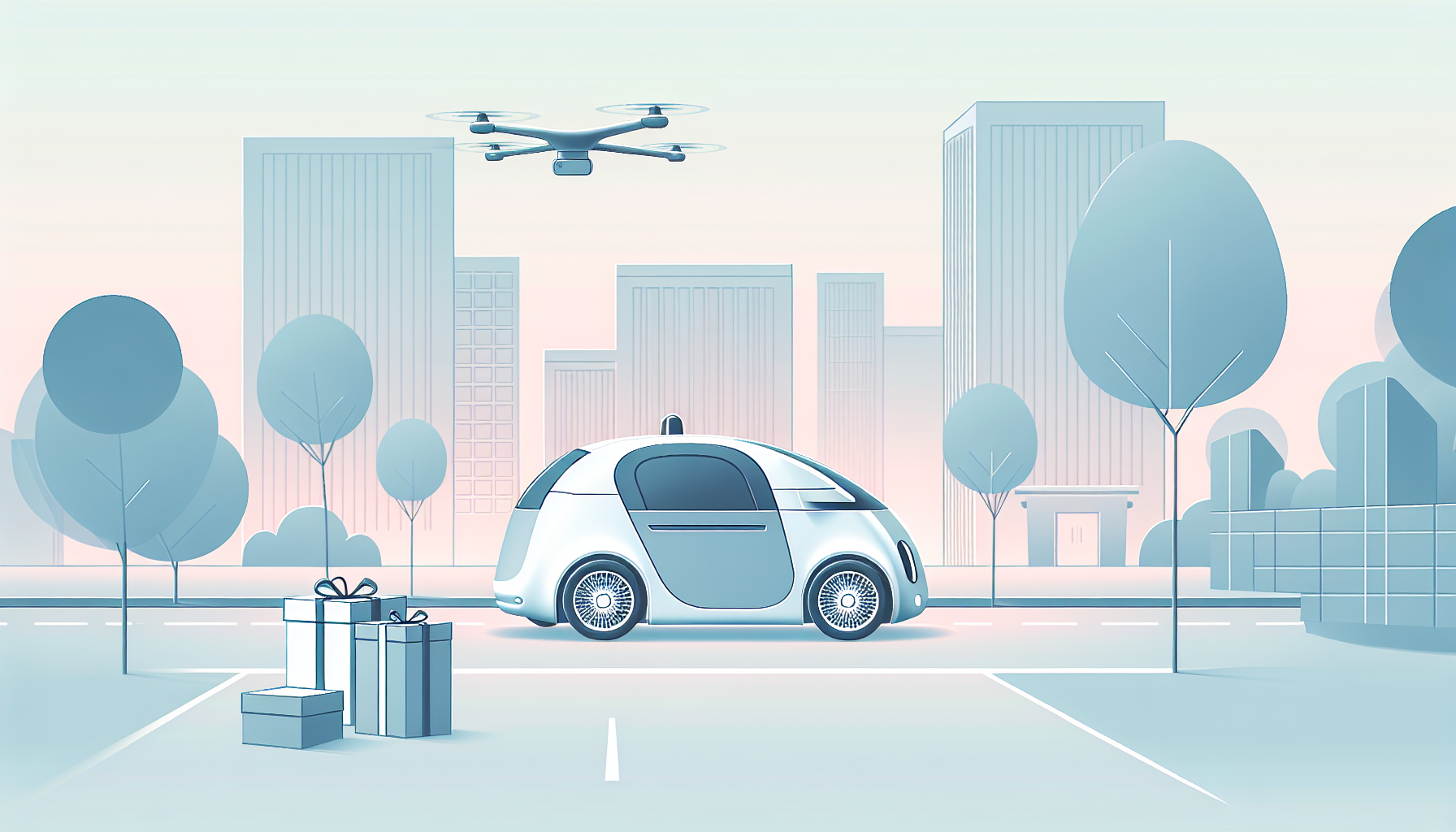Autonomous transportation is a hot topic these days, and it’s easy to feel overwhelmed by all the information out there. You’re not alone if you wonder how these self-driving cars will impact our lives, safety, and the environment. It’s a lot to take in!
But what if I told you that understanding and navigating this new world doesn’t have to be complicated? Stick around, and you’ll discover a treasure trove of ChatGPT prompts designed to demystify autonomous transportation and help you make sense of it all.
From safety improvements to enhancing public awareness, we’ll explore various angles of autonomous transport. Grab your metaphorical seatbelt—it’s time for an exciting ride into the future!
Key Takeaways
- Autonomous vehicles can improve safety through collision avoidance technology and real-time hazard detection.
- Raising public awareness is essential for the acceptance of self-driving cars; effective campaigns can educate on their benefits.
- AI can optimize traffic flow by adjusting signals based on real-time conditions and enabling vehicle-to-everything communication.
- User-friendly interfaces are crucial for passenger comfort; they should prioritize clarity and accessibility features.
- Establishing ethical guidelines is necessary for responsible autonomous vehicle development and deployment.
- Innovative delivery solutions can be generated by addressing current pain points and involving local businesses in the process.
- Staying updated on future trends can shape the strategic direction for autonomous transport development and acceptance.

Top ChatGPT Prompts for Autonomous Transportation
If you’re looking to explore the fascinating world of autonomous transportation, here are some prompts to get you started with ChatGPT.
- “Generate a list of safety features essential for AI-driven transportation solutions.”
- “Explain how vehicle behavior predictions can enhance the efficiency of self-driving cars.”
- “Discuss the impact of transportation AI technologies on urban mobility.”
- “List potential challenges in integrating autonomous vehicles into existing transport systems.”
- “Suggest innovative use cases for autonomous transportation that have yet to be fully developed.”
How to Improve Autonomous Vehicle Safety
Improving the safety of autonomous vehicles is crucial to their widespread acceptance and usage.
Start by implementing advanced collision avoidance technology, which utilizes sensors and cameras to detect potential hazards in real time.
Incorporate sensor fusion for safety, combining data from various sensors to create a comprehensive understanding of the driving environment.
Establish rigorous safety protocols, including regular software updates and testing under diverse conditions.
Real-time safety monitoring systems can alert operators to potential issues before they become critical.
Finally, encourage continual feedback from users and researchers to refine safety measures.
Prompts for Enhancing Public Awareness of Self-Driving Cars
Raising public awareness about autonomous vehicles is vital for smoother integration into society.
Use these prompts to engage ChatGPT and generate awareness strategies:
- “Create an outline for an awareness campaign about the benefits of self-driving cars.”
- “Draft a social media post that educates the public on the safety features of autonomous vehicles.”
- “List important community engagement strategies to inform the public about autonomous systems.”
- “Develop key messages to mitigate fears surrounding self-driving cars.”
Using AI to Optimize Traffic Flow with Autonomous Vehicles
AI is a game-changer when it comes to optimizing traffic flow in our increasingly congested cities.
Deploy AI traffic management systems that dynamically adjust traffic signals based on real-time traffic conditions.
Utilize vehicle-to-everything (V2X) communication to allow vehicles to share information with one another and the infrastructure.
Leverage predictive analytics for traffic optimization by analyzing historical data and anticipating future patterns.
Finally, integrate smart traffic signals that can respond to changes in traffic flow, reducing delays and enhancing safety.

Creating User-Friendly Interfaces for Autonomous Transport Systems
Designing user-friendly interfaces is key to ensuring that passengers feel comfortable with autonomous transport systems.
Start by focusing on intuitive navigation systems that provide clear instructions and minimal distractions.
Consider the needs of diverse users by incorporating accessibility features like voice commands and tactile feedback.
By implementing user testing sessions early, you can gather real feedback to refine interface elements.
Also, use familiar design patterns that users encounter in everyday technology to reduce the learning curve.
- “List the essential features for a user-friendly interface in autonomous vehicles.”
- “Generate tips for implementing accessibility in autonomous transport systems.”
- “Create a prototype design for a self-driving car navigation system.”
- “Describe common user interface issues in self-driving cars and how to solve them.”
Prompts for Developing Ethical Guidelines in Autonomous Transportation
Creating ethical guidelines is crucial in ensuring responsible development within autonomous transportation.
Start by evaluating existing laws and regulations that can inform these guidelines, focusing particularly on safety and accountability.
Consider the ethical implications of AI decision-making, especially in scenarios where lives are at stake.
Encourage a multi-disciplinary approach that includes input from ethicists, engineers, and the community to create well-rounded regulations.
Finally, consider developing a framework for continuous ethical review as technology evolves.
- “Outline ethical considerations for deploying autonomous vehicles in urban settings.”
- “Discuss potential liability issues in case of accidents involving self-driving cars.”
- “Create ethical principles for AI decision-making in autonomous transport.”
- “Generate a list of stakeholders involved in establishing ethical guidelines for autonomous vehicles.”
How to Generate Ideas for Autonomous Delivery Solutions
Generating innovative ideas for autonomous delivery can help in streamlining logistics and enhancing customer satisfaction.
Begin by analyzing current delivery pain points, such as time delays and high costs, to identify opportunities for automation.
Collaborate with local businesses to explore tailored delivery solutions that meet specific community needs.
Consider the role of drones and robots in last-mile delivery to maximize efficiency and reach.
Don’t forget to incorporate feedback from end-users to continuously refine the delivery process.
- “List potential benefits of using drones for last-mile delivery.”
- “Create a set of delivery scenarios for autonomous vehicles in urban areas.”
- “Generate innovative ideas for improving package tracking with autonomous solutions.”
- “Discuss how to integrate traditional logistics with autonomous delivery options.”
Prompts for Exploring Future Trends in Autonomous Transportation
Staying ahead of future trends in autonomous transportation can guide strategic planning and innovation.
Begin by examining technological advancements in AI and machine learning that could shape future vehicles.
Assess the role of policy changes and public acceptance in advancing the deployment of autonomous technologies.
Look into how shared mobility solutions may evolve alongside autonomous transport systems.
Finally, consider the environmental impacts of increased autonomous vehicle usage and sustainability trends.
- “Outline emerging technologies that could impact autonomous vehicle development.”
- “Discuss potential shifts in public transportation with the rise of self-driving cars.”
- “Generate ideas for future features that consumers might expect in autonomous vehicles.”
- “Analyze market trends affecting the adoption of autonomous transport in the coming years.”

Case Studies: Successful Applications of Autonomous Transport
Understanding successful applications of autonomous transport can provide valuable insights into practical implementations.
Review the case of Waymo, which has successfully operated self-driving taxis in Arizona, highlighting user acceptance and operational challenges.
Analyze the efforts of Tesla, particularly its Autopilot feature, which showcases advancements in assisted driving technology.
Look into the partnership between Amazon and UPS for drone deliveries, focusing on efficiency and overcoming regulatory hurdles.
Examine how cities like San Francisco are trialing autonomous shuttles, providing data on user experience and integration with public transport.
Identify lessons learned from failed autonomous vehicle projects to inform future endeavors and avoid repeating mistakes.
How ChatGPT Can Help with Autonomous Vehicle Policy Development
ChatGPT can play a crucial role in developing effective policies for autonomous vehicles.
Utilize ChatGPT to draft comprehensive policy frameworks by asking for specific regulations or best practices in the industry.
Leverage its capabilities for data-driven decision-making by analyzing trends in autonomous vehicle usage and public safety data.
Engage the AI to create stakeholder engagement strategies that involve community input and expert opinions.
Review legislative implications with ChatGPT’s help to ensure compliance with local and federal laws.
- “Draft a policy proposal for integrating autonomous vehicles into existing transportation systems.”
- “List the main challenges in regulating self-driving cars.”
- “Create a framework for stakeholder engagement in autonomous vehicle policy-making.”
- “Outline the impact of autonomous vehicles on existing traffic laws.”
Prompts for Analyzing User Experiences with Autonomous Transportation
Gaining insights into user experiences is vital for improving autonomous transportation systems.
Use these prompts to explore user feedback and perceptions regarding self-driving vehicles:
- “Analyze user feedback on ride-hailing services that utilize autonomous vehicles.”
- “Discuss factors affecting customer satisfaction in autonomous transport.”
- “Generate insights from case studies on passenger perceptions of self-driving cars.”
- “Identify strategies to enhance user trust in autonomous vehicles.”
FAQs
Primary safety concerns include software reliability, sensor malfunctions, cybersecurity vulnerabilities, and the vehicle’s ability to predict and react to unpredictable human behavior in various driving conditions.
AI can optimize traffic flow by analyzing real-time data, predicting congestion patterns, and coordinating the movements of autonomous vehicles to reduce delays and maintain smoother traffic conditions.
Ethical guidelines should address issues such as passenger safety, decision-making in unavoidable accident scenarios, privacy concerns related to data collection, and equitable access to autonomous transport technologies.
Public awareness can be enhanced through educational campaigns, community demonstrations, interactive workshops, and partnerships with local media to disseminate information about the benefits and safety of self-driving cars.
